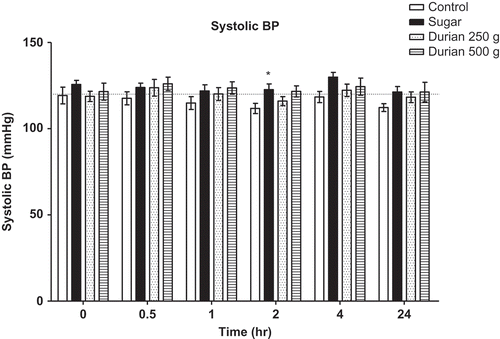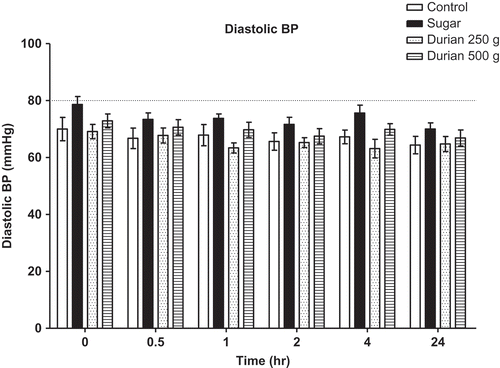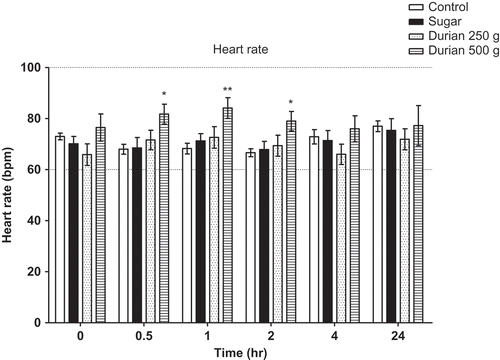Abstract
The effect of durian on cardiovascular health remains controversial. This study investigated the correlation between durian intake and the elevation of blood pressure and heart rate in healthy males. Subjects consumed either placebo, 250 or 500 g durian flesh. The blood pressure and heart rate were measured at various intervals up to 24 h. Both systolic and diastolic blood pressure remained normal for groups given durian. However, a significant increase in heart rate was observed in the group given 500 g of durian at 0.5–2 h. A modest amount of durian intake did not affect blood pressure and heart rate in healthy individuals.
INTRODUCTION
Hypertension remains a major problem worldwide despite various efforts by health care professionals to lessen this global burden. Rampal and co-workers revealed that prevalence of hypertension in Malaysia has increased from 32.9% in 1996 to 40.5% in 2004.[Citation1,Citation2] Unhealthy lifestyle and diet are among the major contributors to the increased incidence of hypertension.[Citation3] Proper management of hypertension is important as it is among the main risk factors for other cardiovascular diseases.[Citation4]
Durian (Durio zibethinus Murray) is coined as “King of Fruits” due to its popularity in providing important nutrients in the Southeast Asian diets. Recently, its peels were evaluated as potential dietary fiber for food supplement.[Citation5] Despite the reputation, very limited information on its specific compositions or chemical entities is available. Among the bioactive compounds in durian that have been investigated were the sugar contents and sulphur-containing compounds.[Citation6] The fleshy pulp is rich in sucrose, fructose, and glucose and the pungent smell is most likely due to the sulphur compounds namely; ethanethiol and disulphide derivatives.[Citation6] It also has a high content of beta carotene and vitamin E.[Citation7]
Traditionally, durian is considered “heaty” because anecdotally it can raise body temperature and elevate blood pressure (BP). Therefore, pregnant women and individuals with high BPs are advised not to eat it.[Citation8,Citation9] Reports suggest that this might be due to its high sugar content.[Citation10,Citation11] The association on how fruits affect BP has not been fully explored. Coconut water and watermelon had been reported to lower BP but to the best of the authors’ knowledge, there has been no report on how durian affects BP and heart rate (HR).[Citation12,Citation13] This study was designed to investigate the effect of durian consumption on BP and HR of healthy individuals.
METHODS
Subjects
Thirty-two healthy male subjects with mean age and body mass index (BMI) of 20.7 + 1.4 years and 20.6 + 2.2 kgm–2, respectively took part in this study. Sample size calculation showed that seven subjects should be used per intervention; however, in this study, eight subjects were used instead.[Citation14] Ethical approval was obtained from the Universiti Kebangsaan Malaysia (UKM) Research Ethics Committee (UKM 1.5.3.5/244/NF-021-11). Subjects were briefed on the nature of the study and written informed consents were obtained from them.
Study Designs
The study was a randomized, single-dose, non-blind design. Prior to the oral dose, subjects were familiarized with the test and were rested for 20 min. Baseline BP (both systolic and diastolic) and HR were taken in a quiet temperature-controlled room (25°C) in a sitting position after an overnight fast (10 h of fasting) and avoiding caffeinated drinks, alcohol, and intense exercise for at least 24 h before the test. BP and HR were measured using the Omron HEM-7203 digital monitor.
After the baseline measurements, subjects were randomly assigned to four groups. Each group received an average amount of durian flesh (250 g), a maximum amount of durian flesh (500 g), placebo or nothing, respectively. Next, all four groups of subjects were given 230 mL of water to wash down the food. BP and HR were measured at the intervals of 0.5, 1, 2, and 4 h, respectively, and the results were recorded. The subjects were gathered again 24 h post study and the BP and HR were measured once more. Durian flesh (D24) used in this study were obtained from the Chow Kit Market. The placebo consisted of sucrose (15 g), glucose (1.8 g), and fructose (1.8 g) at 8:1:1 to match the sugar composition of the 250 g durian flesh.[Citation6] The amount of average and maximum durian flesh to be given to the subjects were decided after a quick survey on 40 individuals in Segamat, Johor. The average amount of durian consumed in a day was five pieces and the maximum amount was 10 pieces. After removal of the seeds, five pulps of durian flesh weighed 250 g while 10 pulps weighed 500 g.
Statistical Analysis
Data generated from this study were analyzed using the Prism 5 software. For each subject, the mean BP before and after commencing the intervention were calculated. The data was expressed as mean ± standard error mean (SEM) and analyzed with one-way analysis of variance (ANOVA) followed by the Dunnett’s post hoc test to compare the effects of durian with control (baseline values).
RESULTS
Durian flesh given was well tolerated by all subjects with no adverse effects reported. shows the mean systolic BP after intervention at different time points between the four groups (normal systolic BP is 120 mmHg and below). There was a significant increase (p < 0.05) in mean systolic pressure after 2 h of intervention for group receiving placebo but the level was slightly above the range (mean = 122.63 mmHg). Durian at the amount of 250 and 500 g did not alter systolic BP in normal individuals. There was no significant increase in mean diastolic pressure after intervention for all groups at different time points (). Durian and sugar at the given amount did not alter diastolic BP in normal individuals (normal diastolic BP is 80 mmHg and below). However, there was a significant increase in HR after 0.5–2 h of durian intake at the dose of 500 g but the levels were brought down after 2 h (). Although an increase in HR was observed, the levels were still within the normal range (60–100 bpm).
DISCUSSION
This study indicates that a single consumption of durian at 250 and 500 g did not alter both systolic and diastolic BP. However, a significant increase in HR was observed at the consumption of 500 g durian. Durian is rich in antioxidants (vitamin E and beta-carotene) minerals (potassium, magnesium, calcium, and sodium),[Citation7] trace elements (iron, zinc, copper, and manganese),[Citation15] sulphur compounds (ethanethiol, ethyl methyl disulphide, diethyl disulphide, ethyl n-propyl disulphide, diethyltrisulphide, 3,5-dimethyl-1,2,4-trithiolane, and 1,1-bis(ethylthio)-ethane), and sugars (sucrose, fructose, and glucose).[Citation6] Potassium has often been associated with its BP lowering effects through its natriuretic property.[Citation16,Citation17] Thus, the constant level of systolic and diastolic BP observed in this study despite the increase in HR might be due to the high level of potassium in durian. Similar results were reported when food rich in potassium, such as bananas and apricots, were consumed.[Citation18,Citation19]
The placebo given in this study showed an isolated systolic hypertension effect where there was an increase in systolic BP while diastolic BP remained normal. This might be attributed to the sugar content as diet rich in carbohydrate has been associated with the elevation of BP.[Citation11,Citation20] Similarly, food scontaining high sugar, such as doughnuts, colas, and chocolate cookies, have been known to increase HR.[Citation21,Citation22] Although it can be argued that a potential limitation of this study is the lack of measurements of blood glucose levels, the higher sugar content in 500 g of durian is the most likely explanation for the observed increase in HR. Durian, which is abundant in most states in Malaysia, provides a comfortable income to farmers during its season. It is usually eaten raw or included as a main ingredient in desserts, porridges, fritters, cakes, and ice creams. Controversial beliefs that it affects cardiovascular parameters has discouraged individuals with cardiovascular risk factors to consume durian. More studies on how durian affects individual health status are needed to educate the public on the risk and the benefit of durian consumption.
CONCLUSIONS
This study showed that consumption of durian at an average amount (250 g) does not affect systolic and diastolic BP or HR, but a higher consumption (500 g) will alter HR at 0.5–2 h after intake. However, the study was carried out on healthy male subjects aged 20–22 years old. The changes in physiological status of individuals with age might interfere with the tolerance level of durian intake. Therefore, further studies are warranted for healthy older individuals and pre-hypertensive or hypertensive subjects to dismiss or confirm the anecdotal claims.
FUNDING
The authors would like to thank the Faculty of Pharmacy, Universiti Kebangsaan Malaysia for financing the project.
Additional information
Funding
REFERENCES
- Suzana, S.; Kee, C.C.; Ab Rahman, J.; Noor Safiza, M.N.; Geok, L.K.; Jamaiyah, H. National Health and Morbidity Survey II. Asia-Pacific Journal of Public Health 2010, 24, 318–329.
- Rampal, L.; Rampal, S.; Azhar, M.Z.; Rahman, A.R. Prevalance, Awareness, Treatment, and Control of Hypertension in Malaysia: A National Study of 16,440 Subjects. Public Health 2008, 122, 11–18.
- Singh, R.B.; Suh, I.L.; Chaithiraphan, S.; Laothavorn, P.; Sy, R.G.; Babilonia, N.A.; Rahman, A.R.A.; Sheikh, S.; Tomlinson, B.; Sarraf-Zadigan, N. Hypertension and Stroke in Asia: Prevalence, Control, and Strategies in Developing Countries for Prevention. Journal of Human Hypertension 2000, 14, 749–763.
- Rosamond, W.; Flegal, K.; Friday, G.; Furie, K.; Go, A.; Greenlund, K.; Haase, N.; Ho, M.; Howard, V.; Kissela, B.; Kittner, S.; Lloyd-Jones, D.; McDermott, M.; Meigs, J.; Moy, C.; Nichol, G.; O’Donnell, C.J.; Roger, V.; Rumsfeld, J.; Sorlie, P.; Steinberger, J.; Thom, T.; Wasserthiel-Smoller, S.; Hong, Y. Heart Disease and Stroke Statistics—2007 Update: A Report from the American Heart Association Statistics Committee and Stroke Statistics Subcommittee. Circulation 2007, 115, e69–e171.
- Wachirasiria, K.; Sithisam-anga, D.; Suwannatupa, T. Potential of Selected Tropical Fruit Peels As Dietary Fiber in Functional Foods. International Journal of Food Properties 2015, 18(6), 1306–1316.
- Voon, Y.Y.; Sheikh Abdul Hamid, N.; Rusul, G.; Osman, A.; Quek, S.Y. Characterisation of Malaysian Durian (Durio Zibethinus Murr.) Cultivars: Relationship of Physicochemical and Flavour Properties with Sensory Properties. Food Chemistry 2007, 103, 1217–1227.
- Charoensiri, R.; Kongkachuichai, R.; Suknicom, S.; Sungpuaq, P. Beta-Carotene, Lycopene, and Alpha-Tocopherol Contents of Selected Thai Fruits. Food Chemistry 2009, 113, 202–207.
- Fuller, T. Fans Sour on Sweeter Version of Asia’s Smelliest Fruit; The New York Times: New York, NY, 2007.
- Chua, A. Killer Durians; The Star: Kuala Lumpur, Malaysia, 2012.
- Roongpisuthipong, C.; Banphotkasem, S.; Komindr, S.; Tanphaichitr, V. Postprandial Glucose and Insulin Responses to Various Tropical Fruits of Equivalent Carbohydrate Content in Non-Insulin-Dependent Diabetes Mellitus. Diabetes Research and Clinical Practice 1991, 14(2), 123–131.
- Shah, M.; Adams, H.; Garg, A. Effect of High Carbohydrate Or High Cis-Monounstarurated Fat Diets on Blood Pressure: A Meta Analysis of Intervention Trials. American Journal of Clinical Nutrition 2007, 85, 1251–1256.
- Alleyne, T.; Roache, S.; Thomas, C.; Shirley, A. Control of Hypertension by the Use of Coconut Water and Mauby: Two Tropical Food Drinks. West Indian Medical Journal 2005, 54(1), 3–8.
- Figueroa, A.; Sanchez-Gonzalez, M.A.; Perkins-Veazie, P.M.; Arjmandi, B.H. Effects of Watermelon Supplementation on Aortic Blood Pressure and Wave Reflection in Individuals with Prehypertension: A Pilot Study. American Journal of Hypertension 2011, 24(1), 40–44.
- Snedecor, G.; Cochran, W. Statistical Methods; Iowa State University Press: Ames, Iowa, 1989.
- Leontowicz, H.; Leontowicz, M.; Haruenkit, R.; Poovarodom, S.; Jastrzebski, Z.; Drzewiecki, J.; Ayala, A.L.M.; Jesion, I.; Trakhtenberg, S.; Gorinstein, S. Durian (Durio Zibethinus Murr.) Cultivars As Nutritional Supplementation to Rat’s Diets. Food Chemistry Toxicology 2008, 46, 581–589.
- Whelton, P.K.; He, J.; Cutler, J.A.; Brancati, F.L.; Appel, L.J.; Follmann, D.; Klag, M.J. Effects of Oral Potassium on Blood Pressure: Meta-Analysis of Randomised Controlled Clinical Trials. Journal of the American Medical Association 1997, 277(20), 1624–1632.
- Langford, H.G. Sodium-Potassium Interaction in Hypertension and Hypertensive Cardiovascular Disease. Hypertension 1991, 17(1), I-155–I-157.
- Walford, R.L.; Harris, S.B.; Gunion, M.W. The Calorically Restricted Low-Fat Nutrient Dense Diet in Biosphere 2 Significantly Lowers Blood Glucose, Total Leukocyte Count, Cholesterol, and Blood Pressure in Humans. Proceedings of the National Academy of Sciences of the United States of America 1992, 89, 11533–11537.
- Karanja, N.M.; Obarzanek, E.; Lin, P.H.; McCullough, M.L.; Phillips, K.M.; Swain, J.F.; Champagne, C.M.; Hoben, K.P. Descriptive Characteristics of the Dietary Patterns Used in the Dietary Approaches to Stop Hypertension Trial. Journal of the American Dietetic Association 1999, 99(8), S19–S27.
- Rebello, T.; Hodges, R.E.; Smith, J.L. Short-Term Effects of Various Sugars on Antinatriuresis and Blood Pressure Changes in Normotensive Young Men. American Journal of Clinical Nutrition 1983, 38, 84–94.
- Liu, S.; Willett, W.C.; Stampfer, M.J.; Hu, F.B.; Franz, M.; Sampson, L.; Hennekens, C.H.; Manson, J.E. A Prospective Study of Dietary Glycaemic Load, Carbohydrate Intake, and Risk of Coronary Heart Disease in U.S. Women. American Journal of Clinical Nutrition 2000, 71, 1455–1461.
- Howard, B.V.; Wylie-Rosett, J. Sugar and Cardiovascular Disease. A Statement for Helathcare Professionals from the Committee on Nutrition of the Council on Nutrition, Physical Activity and Metabolism of the American Heart Association. Circulation 2002, 106, 523–527.



